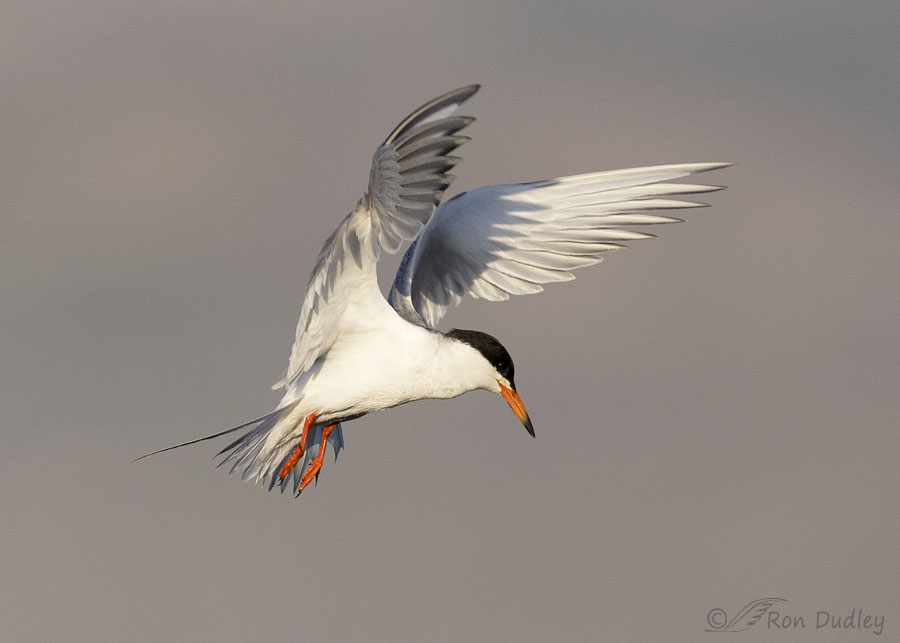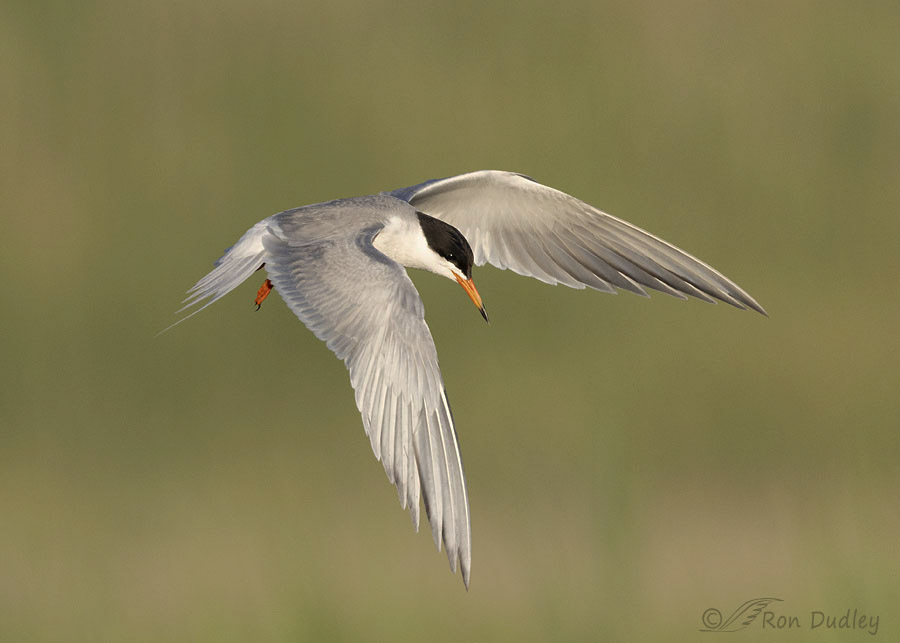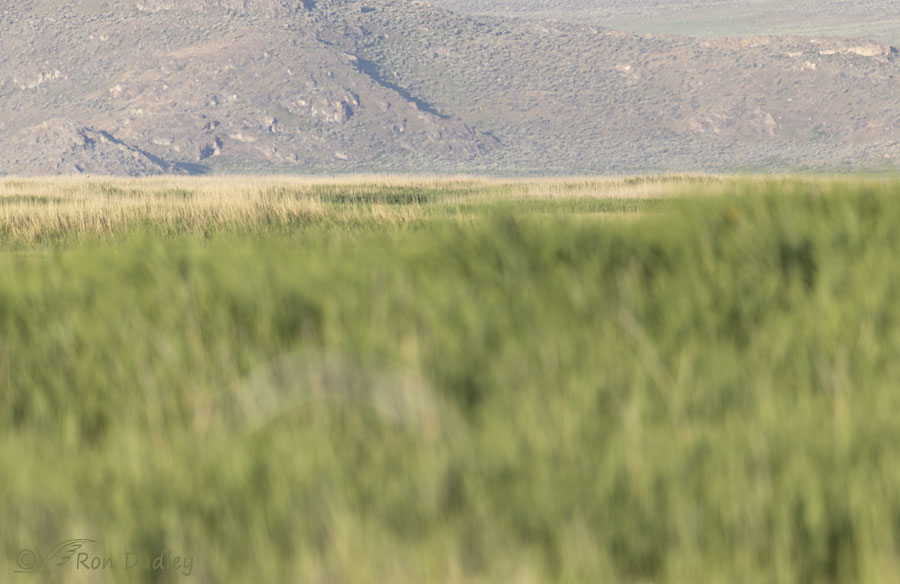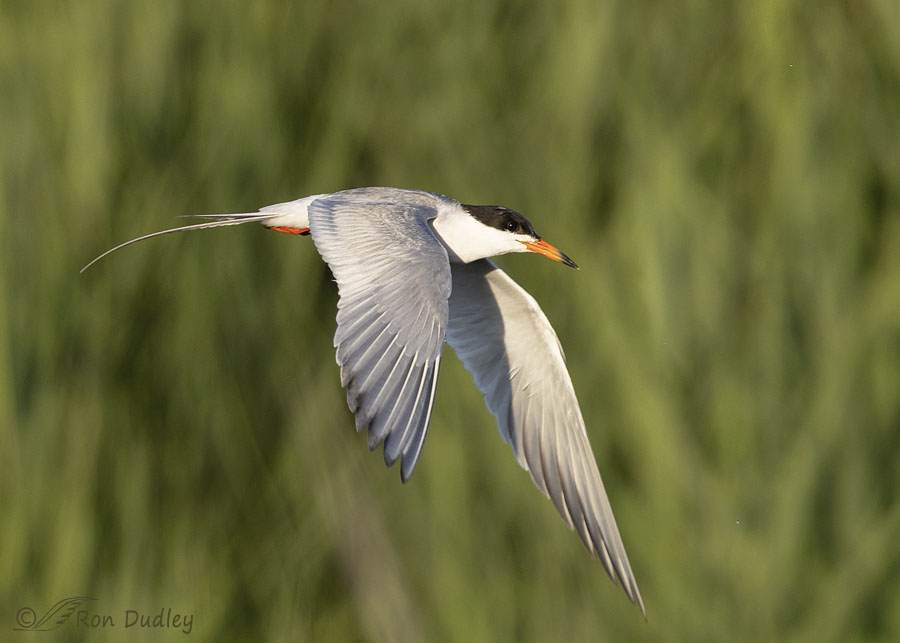Recently I’ve posted several photos of Forster’s Terns in flight that were taken on my last trip to Bear River MBR 12 days ago. The following four photos were taken that same morning, at the same spot along one of the canals.

1/5000, f/5.6, ISO 800, Canon R5, Canon EF500mm f/4L IS II USM + 1.4 tc, not baited, set up or called in
Usually my photos of terns in flight have blue sky backgrounds but on that morning I didn’t get a single shot like that because the terns were flying and hovering unusually low over the canal. A few of my photos were like this one, with the far-away Promontory Mountains in the background. It isn’t my favorite background but then neither is plain blue sky.
This bird is obviously hovering. Notice that the primaries and secondaries on its right wing appear to be acting semi- independently of each other as they react to the forces of flight during hovering. It’s something I’ve noticed before with hovering birds. I wish I understood why that often seems to be the case with hovering birds, but I don’t.
1/2500, f/5.6, ISO 800, Canon R5, Canon EF500mm f/4L IS II USM + 1.4 tc, not baited, set up or called in
Usually on that morning the terns weren’t flying high enough to get the mountains in the background so I got green vegetation growing along the canal banks, or directly behind the canal banks, instead. I like these backgrounds better.

1/4000, f/5.6, ISO 800, Canon R5, Canon EF500mm f/4L IS II USM + 1.4 tc, not baited, set up or called in
Occasionally I got a mix of green and dead vegetation in the background, which I also like. In fact, I like pretty much everything about this photo.
When the bokeh of my backgrounds is as soft as it usually is with my lens, little or no detail can be perceived so I suspect viewers often wonder what it really looked like back there. What caused that color, or that mix of colors or a particular implied texture?
With that introduction, I decided to put one of my mistakes of that morning to good use.

This photo was taken by mistake, when the tern I was trying to photograph zipped out of frame incredibly fast, so my active focus point grabbed onto the base of the Promontory Mountains in the far background. It’s what I call an “air shot” that resulted when my reflexes weren’t quick enough to avoid taking the shot with no bird in the frame. It’s full frame (uncropped) except for a little loss when I rotated the photo to level during processing.
Every photo I took that morning was taken from the same spot and when the bird was in about the same place over the canal so somewhere in this photo is the background for each of them, or at least most of them. The background in the first photo in this post is the mountains at the top of the frame and the background for the other two photos is somewhere amongst the greenery. The canal the terns were fishing is barely out of frame at bottom.
More than you wanted to know about backgrounds perhaps. Or maybe not.
Ron
.



When might you and Dan Gleason actually meet in person? You complement each other’s knowledge and experience, to your readers’ great pleasure. (If you do ever get up to Eugene OR, let me know, as I would offer you my guest room.)
Elise, I don’t know if or when it will happen but it would be great fun if it did.
Thank you and Dan both. While I am usually content to marvel and wonder it is nice to have the background that both of you gave to this post.
Thank, EC. For me, Dan’s input often makes me appreciate my images even more, because of the deeper understanding he provides.
Terns are always fun to watch. Yes, the primaries and secondaries do move independently. From the wrist outward is the manus (hand) and that’s where the primaries are attached. On take-off the primaries separate slightly and each acts as its own airfoil to provide lift. The wrist is bent so that those feathers travel further forward than the secondaries. It also helps gain a steep angle of attack to achieve lift. Once in the air and moving forward, the secondaries increase in importance to help make the entire wing an airfoil for lift. Think of the primaries as the propeller of a fixed wing aircraft. To hover, most of the work is done by the primaries as the wrist flexes forward. An angle of attack of approximately 15° provides maximum lift. Beyond that, turbulence over the wing is too great and stall happens and the bird would fall. So hovering is a lot of work involving the primaries to create a balance between lift and drag or stall. That can only work if the primaries and secondaries work independently.
Fascinating, Dan. I love it when you provide knowledgeable explanations for phenomena I observe in the field and/or document with my photos but don’t fully understand. And you do it often.
WOW! Definitely not a simple construct!
That first shot is pretty amazing. I didn’t even notice the background because I was so focused on the tern! I also enjoy seeing a wide-angle shot of where your lens is pointed. It definitely helps with perspective (and marveling at how you can ID a little tiny speck in the distance!). I like the soft green/gold bokeh too. The SoCal mountains and foothills are finally turning after an extended green spring.
Marty, actually they usually aren’t “a little tiny speck in the distance”. Big lenses like mine don’t magnify as much as most folks think they do. The large size of lenses like mine is at least as much about light-gathering as it is about magnification. So the birds I’m photographing are significantly larger than little specks to the naked eye. If they aren’t they’re usually not worth photographing.
I agree with Michael and Everett. Seeing the landscape helps me understand the bird’s story, and where you are in the story, too. The last photo is a beautiful one in its own right, even as a mistake and without the bird!
“Seeing the landscape helps me understand the bird’s story, and where you are in the story, too.”
Good. Then I succeeded with my intention for including that photo. Thanks, Carolyn.
Excellent series!
Thanks, Charlotte.
Ditto for me re Michael’s input. Like the green background and the Terns in flight make for some really neat shots.
Thank you, Everett.
Beautiful shots – always interesting how different backgrounds interact with the subject. REALLY annoying when the focus “locks in” on everything but what is wanted…. Seems impossible that the Tern’s wing could flex in that direction in the 1st shot as well as primaries and secondaries appearing to be moving differently? Air flow perhaps?
Seems impossible that the Tern’s wing could flex in that direction in the 1st shot as well as primaries and secondaries appearing to be moving differently? Air flow perhaps?
Thanks, Judy. I suspect it’s air flow/pressure but I’ve always wondered if the bird actually has some control over it.
In shot #1, I especially liked the shadow that the right wing cast across the
left– it added depth and accentuated the primary- independent- of- secondary
function that you noted– loved Suzanne’s pun…….too true !
Thank you, Kris. I could kick myself for not thinking of Suzanne’s pun. It seems so obvious and appropriate…
Always love learning how you see what you shoot, and one good tern deserves another.
“one good tern deserves another”
Damn, wish I’d thought of that.
Well Ron I for one appreciate anytime you give a peek into your process and working environment. There is a story there; one that makes the reader feel a part of things. And I’m naturally curious enough to want to read them.
Very good to know, Michael. Thank you.